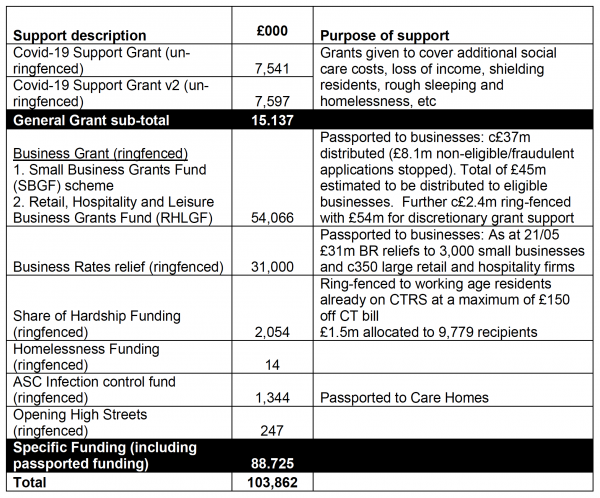LBWF and COVID-19 (3)
With the passage of time, there is growing clarity about how LBWF has been affected by COVID-19, and to what extent the impact is being mitigated by special support received from the government.
The first discussion of these important issues occurred in late April, when a report on them was debated by Cabinet.
LBWF officers had produced 15 initial estimates of the possible gross damage (i.e. the damage disregarding any extra government assistance) which played with various assumptions about the pandemic’s likely length and the size of the extra demand for social care, and concluded that the range would be of the order £16,484,600 to £50,715,700.
Figures quoted in the covering paper focused on which figure was most likely. The ‘initial financial exposure’ was forecast to be ‘approximately £25.613m to the end of June’, while elsewhere in the same document, the ‘[overall] financial exposure that the Council currently estimates’ was put at c£38.5m., both figures dwarfing the £7.540m. that so far had been received in direct aid from Westminster.
A press release of about the same time was equally alarming, quoting LBWF Leader, Cllr. Clare Coghill, warning that ‘“If lockdown measures continue for 12 weeks the full impact on our finances could be up to £40 million, roughly 10 per cent of our planned budget for this year”’.
In June 2020, the Waltham Forest Echo gave Cllr. Coghill extensive front-page space in which to elaborate on her views. Her most eye-catching point was that LBWF initially had been encouraged to spend as much as was necessary to deal with the pandemic, and promised that the government would pick up the tab, but subsequently ministers had ‘“rowed back”’ on their initial pledges, meaning that LBWF was having to ‘“dip into its reserves”’ and contemplate service changes. And in an accompanying aside, the editor of the Echo added credence to these claims, observing ‘the council warned back in April that its projected deficit for the pandemic was now £40m’, the qualifying words of the earlier press release, ‘“could be up to”’, omitted without explanation.
More recently still, a paper presented to the Budget and Performance Committee provides both an update and some new information.
On the specific subject of LBWF finances, it notes that while ‘the estimated gross annual forecast of costs’ is ‘relatively stable at c£38.5m.’, since the government has increased direct assistance to £15.137m., ‘the total net cost exposure risk for the Council stands at £23.363m.’
But what is perhaps more interesting is that, for the first time, the paper reveals that LBWF is benefitting from a much bigger package from the government than previously has been publicly acknowledged. The following table summarises ‘The total level of financial support given either to the Council, or through it to discharge its duties’:
Of course, much of the larger picture remains fluid. LBWF officers rightly stress that many of the figures they quote are estimates. Government aid will likely increase further. The pandemic, anyway, is not over.
But it does seem that, on the basis of the evidence currently available, LBWF’s predicament, while serious, will not be of the magnitude previously claimed.
Needless to say, it is inevitable that some politicians will continue to use this issue for their own ends: that is in their nature.
As ever, however, such posturing should not be confused with the facts.

